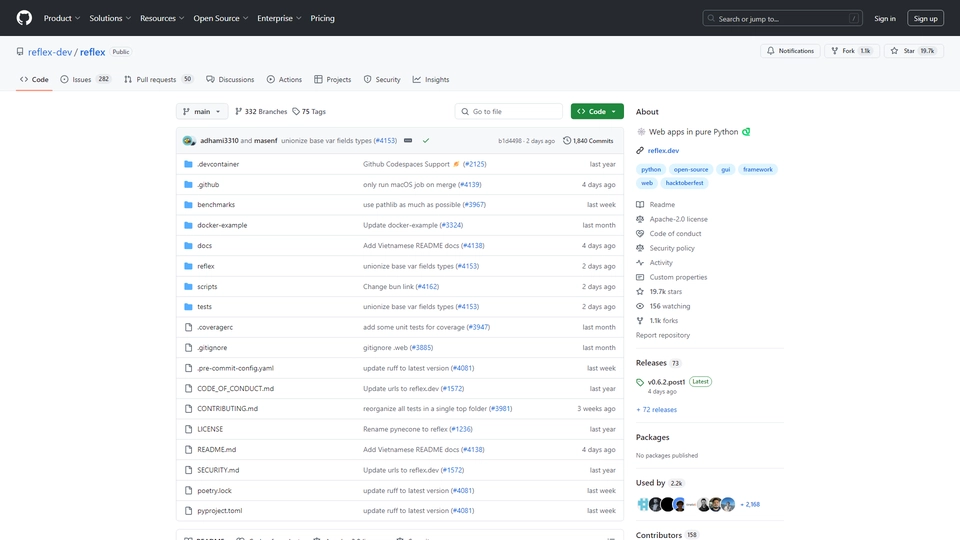What Is Reflex
Reflex is an innovative open-source framework crafted by Nikhil—a former AI professional at DriveAI and Apple—designed to simplify the creation of full-stack web applications using only Python. By harnessing the popularity and versatility of Python, Reflex addresses the challenges faced by developers who find traditional frontend technologies like JavaScript and React overwhelming and cumbersome, especially during deployment.
The primary goal of Reflex is to streamline the web app development process for skilled engineers already proficient in Python but unfamiliar with frontend tools. Traditional web development often necessitates learning new languages, which poses significant barriers. Reflex eliminates this issue by allowing developers to create, customize, and deploy web applications using a single language, ensuring a smooth transition from backend to frontend.
Significant issues with no-code and low-code solutions include limited flexibility and confusion due to incomplete toolchains. Reflex counters this by offering a comprehensive, intuitive framework capable of supporting both small prototypes and full-scale production applications. With features like easy deployment through a single command and zero configuration, it effectively bridges the gap between different aspects of development.
Industries and teams seeking efficiency, flexibility, and an all-Python development environment stand to benefit immensely from Reflex. It empowers engineering teams to function seamlessly across the full stack, removing the need for separate specialists and fostering a more integrated development process. By doing so, Reflex pushes the boundaries of what's possible in Python web development, merging simplicity with the power of traditional frameworks.
Reflex Features
Reflex is an open-source framework designed to enable developers to build full-stack web apps using pure Python, offering a seamless transition for Python developers looking to create web applications. Here are the key features of Reflex:
Core Functionalities
Reflex allows developers to use a single language, Python, for building both the frontend and backend of web applications. This eliminates the need for developers to switch between languages and familiarize themselves with complex frontend technologies like JavaScript or React. With Python being a versatile and widely-used language, this significantly lowers the barrier to entry for web development.
Customization Options
Reflex provides a completely customizable user interface, giving developers the flexibility to create and design web applications that meet specific requirements. This flexibility ensures that developers can achieve the same level of customization and performance they expect from traditional web frameworks, without compromising on the ease of use that Reflex offers.
Deployment Capabilities
One of the standout features of Reflex is its straightforward deployment process. With a single command, reflex deploy, developers can deploy their web apps without any elaborate configurations. This reduces the complexities traditionally associated with the deployment process, making it accessible even for those with limited experience in web deployment.
Benefits to Users
Reflex empowers teams by enabling all engineers to work across the entire stack—frontend, backend, and infrastructure. This integration means that dedicated engineers for each part of the stack are not necessary, allowing for more fluid team dynamics and collaboration across different areas of application development.
Target Audience and Use Cases
Reflex targets Python developers who have found traditional web development overwhelming due to the necessity of learning multiple languages and tools. It serves individuals and teams looking to build web applications without the steep learning curve typical of conventional methods. The framework is particularly beneficial for projects that require rapid prototyping and deployment, thanks to its ease of use and comprehensive handling of both frontend and backend processes.
Reflex aims to leave behind outdated methods, paving the way for modern, integrated web app development within the Python ecosystem.
Reflex FAQs
Reflex Frequently Asked Questions
What is Reflex?
Reflex is an open-source framework that allows developers to build full-stack web applications using only Python. It simplifies the process by eliminating the need to learn traditional frontend tools like JavaScript or React, providing a seamless development and deployment experience.
How does Reflex simplify web app deployment?
Reflex enables developers to deploy web applications with a single command, 'reflex deploy', requiring zero configuration. This feature drastically reduces the complexity and time involved in deploying web apps.
What are the main benefits of using Reflex?
The main benefits of using Reflex include developing web apps entirely in Python, ease of getting started without prior web development experience, full flexibility to create customizable apps, and handling the entire stack from frontend to backend and deployment.
Why was Reflex created?
Reflex was created to allow Python developers to build scalable and customizable web applications without needing to learn additional frontend technologies like JavaScript. It addresses the gap between flexibility and ease found in recent no code and low code alternatives.
Who can benefit from using Reflex?
Both skilled engineers and those new to web development can benefit from using Reflex. It allows developers with Python experience to leverage their existing skills without learning new languages and tools, streamlining the process of building and deploying web apps.
What problem does Reflex solve for developers?
Reflex solves the problem of having to use multiple tools and languages to build web apps. By using Python for the entire development process, it eliminates the overhead associated with switching between different programming languages and ecosystems.
